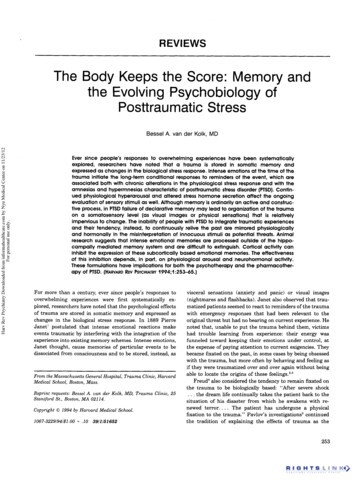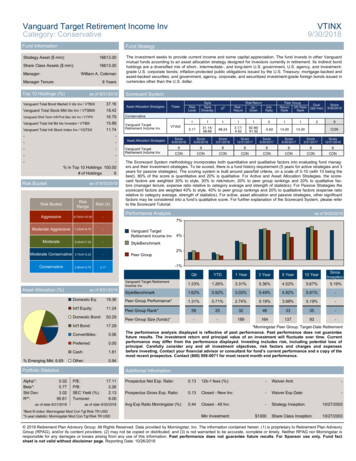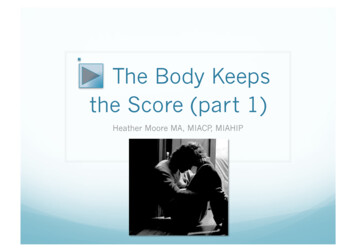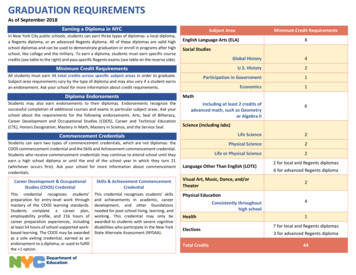
Transcription
The Body Keeps the Score: Memory andthe Evolving Psychobiology ofPosttraumatic StressHarv Rev Psychiatry Downloaded from informahealthcare.com by Nyu Medical Center on 11/23/12For personal use only.Bessel A. van der Kolk. MDEver since people’s responses to overwhelming experiences have been systematicallyexplored, researchers have noted that a trauma is stored in somatic memory andexpressed as changes in the biological stress response. Intense emotions at the time of thetrauma initiate the long-term conditional responses to reminders of the event, which areassociated both with chronic alterations in the physiological stress response and with theamnesias and hypermnesias characteristic of posttraumatic stress disorder (PTSD). Continued physiological hyperarousal and altered stress hormone secretion affect the ongoingevaluation of sensory stimuli as well. Although memory is ordinarily an active and constructive process, in PTSD failure of declarative memory may lead to organization of the traumaon a somatosensory level (as visual images or physical sensations) that is relativelyimpervious to change. The inability of people with PTSD to integrate traumatic experiencesand their tendency, instead, to continuously relive the past are mirrored physiologicallyand hormonally in the misinterpretation of innocuous stimuli as potential threats. Animalresearch suggests that intense emotional memories are processed outside of the hippocampally mediated memory system and are difficult to extinguish. Cortical activity caninhibit the expression of these subcortically based emotional memories. The effectivenessof this inhibition depends, in part, on physiological arousal and neurohormonal activity.These formulations have implications for both the psychotherapy and the pharmacotherREV PSYCHIATRY1994;1:253-65.)apy of PTSD. (HARVARDFor more than a century, ever since people’s responses tooverwhelming experiences were first systematically explored, researchers have noted that the psychological effectsof trauma are stored in somatic memory and expressed aschanges in the biological stress response. In 1889 PierreJanet’ postulated that intense emotional reactions makeevents traumatic by interfering with the integration of theexperience into existing memory schemes. Intense emotions,Janet thought, cause memories of particular events to bedissociated from consciousness and to be stored, instead, asFrom the Massachusetts General Hospital, Trauma Clinic, HarvardMedical School, Boston, Mass.Reprint requests: Bessel A. van der Kolk, MD, Trauma Clinic, 25Staniford St., Boston, M A 02114.Copyright 0 1994 by Harvard Medical School.1067-3229194/ 1.00 .1039/1/51652visceral sensations (anxiety and panic) or visual images(nightmares and flashbacks). Janet also observed that traumatized patients seemed to react to reminders of the traumawith emergency responses that had been relevant to theoriginal threat but had no bearing on current experience. Henoted that, unable to put the trauma behind them, victimshad trouble learning from experience: their energy wasfunneled toward keeping their emotions under control, atthe expense of paying attention to current exigencies. Theybecame fixated on the past, in some cases by being obsessedwith the trauma, but more often by behaving and feeling asif they were traumatized over and over again without beingable to locate the origins of these feeling .', Freud4 also considered the tendency to remain fixated onthe trauma to be biologically based: “After severe shock. . . the dream life continually takes the patient back to thesituation of his disaster from which he awakens with renewed terror. . . The patient has undergone a physicalfixation to the trauma.” Pavlov’s investigations‘ continuedthe tradition of explaining the effects of trauma as the253
Harvard Rev PsychiatryHarv Rev Psychiatry Downloaded from informahealthcare.com by Nyu Medical Center on 11/23/12For personal use only.254 van der Kolkresult of lasting physiological alterations. He, and othersusing his paradigm, coined the term defensive reaction for acluster of innate reflexive responses to environmentalthreat. Many studies have shown how the response topotent environmental stimuli (unconditional stimuli) becomes a conditioned reaction. After repeated aversive stimulation, intrinsically nonthreatening cues associated withthe trauma (conditional stimuli) can elicit the defensivereaction by themselves (conditional response). A rape victimmay respond to conditioned stimuli, such as the approach ofan unknown man, as if she were about to be raped againand experience panic. Pavlov also pointed out that individual differences in temperament accounted for the diversityof long-term adaptations to trauma.Abraham Kardiner,‘ who first systematically definedposttraumatic stress for American audiences, noted thatsufferers of “traumatic neuroses” develop an enduring vigilance for and sensitivity to environmental threat. Hestated:The nucleus of the neurosis is a physioneurosis. Thisis present on the battlefield and during the entireprocess of organization; it outlives every intermediary accommodative device, and persists in thechronic forms. The traumatic syndrome is everpresent and unchanged.In Men Under Stress, Grinker and Spiege17 cataloged thephysical symptoms of soldiers in acute posttraumatic states:flexor changes in posture, hyperkinesis, “violently propulsive gait,” tremor at rest, masklike facies, cogwheel rigidity,gastric distress, urinary incontinence, mutism, and a violentstartle reflex. They noted the similarity between many ofthese symptoms and those of diseases of the extrapyramidalmotor system. Today we understand them to result fromstimulation of biological systems, particularly of ascendingamine projections. Contemporary research on the biology ofposttraumatic stress disorder (PTSD), generally uninformedby this earlier research, confirms that there are persistentand profound alterations in stress hormone secretion andmemory processing in subjects with PTSD.SYMPTOMAT0LOGYStarting with Kardiner‘ and closely followed by Lindemann,’ a vast literature on combat trauma, crimes, rape,kidnapping, natural disasters, accidents, and imprisonment’-” has shown that the trauma response is bimodal:hypermnesia, hyperreactivity to stimuli, and traumatic reexperiencing coexist with psychic numbing, avoidance, a m nesia, and anhedonia. These responses to extreme experiences are so consistent across the different forms of traumatic stimuli that this bimodal reaction appears to be theJanuary/February 1994normative response to any overwhelming and uncontrollable experience. In many persons who have undergone severestress, the posttraumatic response fades over time, whereasin others it persists. Much work remains to be done to spellout issues of resilience and vulnerability, but magnitude ofexposure, previous trauma, and social support appear to bethe three most significant predictors for development ofchronic PTSD.13.14In an apparent attempt to compensate for chronic hyperarousal, traumatized people seem to shut down: on a behavioral level by avoiding stimuli reminiscent of the trauma,and on a psychobiological level by emotional numbing,which extends to both trauma-related and everyday experience.15Thus subjects with chronic PTSD tend to suffer froma numbed responsiveness to the environment, punctuatedby intermittent hyperarousal in reaction to conditional traumatic stimuli. However, as Pitman and c o l l e a g ehaves’ pointed out, in PTSD the stimuli that precipitate emergencyresponses may not be conditional enough: many triggers notdirectly related to the traumatic experience may precipitateextreme reactions. Subjects with PTSD suffer both fromgeneralized hyperarousal and from physiological emergencyreactions to specific reminder . .' The loss of affective modulation that is so central inPTSD may help to explain the observation that traumatizedpersons lose the capacity to use affect states as signals.” Insubjects with PTSD, feelings are not used as cues to attendto incoming information and arousa! is likely to precipitateflight-or-fight reactions.’’ Thus they often go immediatelyfrom stimulus to response without psychologically assessingthe meaning of an event. This makes them prone to freezeor, alternatively, to overreact and intimidate others in response to minor provocations.12,20PSYCHOPHYSIOLOGYAbnormal psychophysiological responses in PTSD have beenobserved at two different levels: (1) in response to specificreminders of the trauma and (2) in response to intense butneutral stimuli, such as unexpected noises. The first paradigm implies heightened physiological arousal to sounds,images, and thoughts related to specific traumatic incidents.Many studies 20-25 have confirmed that traumatized individuals respond to such stimuli with significant conditionedautonomic reactions -for example, increases in heart rate,skin conductance, and blood pressure. The highly elevatedphysiological responses accompanying the recall of traumatic experiences that happened years, and sometimes decades, before illustrate the intensity and timelessness withwhich traumatic memories continue to affect current exper i e n e . This. ’ phenomenon has been understood in the
Harvard Rev Psychiattyvan der Kolk 255Harv Rev Psychiatry Downloaded from informahealthcare.com by Nyu Medical Center on 11/23/12For personal use only.Volume 1, Number 5light of Lang’s work,26which shows that emotionally ladenimagery correlates with measurable autonomic responses.Lang has proposed that emotional memories are stored as“associative networks” that are activated when a person isconfronted with situations that stimulate a sufficient number of elements within such networks. One significant measure of treatment outcome that has become widely acceptedin recent years is a decrease in physiological arousal inresponse to imagery related to theHowever, Shalev and coworkers2’ have shown that desensitization tospecific trauma-related mental images does not necessarilygeneralize to recollections of other traumatic events as well.Kolb””was the first to propose that excessive stimulationof the central nervous system (CNS) at the time of thetrauma may result in permanent neuronal changes thathave a negative effect on learning, habituation, and stimulus discrimination. These neuronal changes would not depend on actual exposure to reminders of the trauma forexpression. The abnormal startle response characteristic ofPTSD’O exemplifies such neuronal changes.Although abnormal acoustic startle response (ASR) hasbeen seen as a cardinal feature of the trauma response formore than half a century, systematic explorations of theASR in PTSD have just begun. The ASR is a characteristicsequence of muscular and autonomic responses elicited bysudden and intense s t i m l i . ”The. ’ neuronal pathwaysinvolved consist of only a small number of mediating synapses between the receptor and effector and a large projection to brain areas responsible for CNS activation andstimulus eval ation. ’The ASR is mediated by excitatoryamino acids such as glutamate and aspartate and is modulated by a variety of neurotransmitters and second messengers at both the spinal and the supraspinal levels.3zHabituation to the ASR in normal human subjects occurs afterthree to five presentation . "Several studies 33-36 have shown abnormalities in habitfound auation to the ASR in PTSD. Shalev andfailure to habituate to both CNS- and autonomic nervoussystem-mediated responses to ASR in 93%of subjects in thePTSD group, compared with 22% of the control subjects.Interestingly, persons who previously met criteria for PTSDbut no longer do so continue to show failure of habituationto the ASR (van der Kolk BA, et al., unpublished data,1991-1992; Pitman RK, et al., unpublished data, 19911992), which raises the question of whether abnormal habituation to acoustic startle may be a marker or a vulnerability factor for development of PTSD.The failure to habituate to acoustic startle suggests thattraumatized people have difficulty evaluating sensorystimuli and mobilizing appropriate levels of physiologicalThus the inability of people with PTSD properlyto integrate memories of the trauma and the tendency theyhave to get mired in a continuous reliving of the past aremirrored physiologically by the misinterpretation of innocuous stimuli, such as unexpected noises, as potentialthreats.HORMONAL STRESS RESPONSEAND PSYCHOBIOLOGYPTSD develops after exposure to events that are intenselydistressing. Extreme stress is accompanied by the release ofendogenous neurohormones, such as cortisol, epinephrineand norepinephrine, vasopressin, oxytocin, and endogenousopioids. These hormones help the organism to mobilize theenergy required to deal with the stress; they induce reactions ranging from increased glucose release to enhancedimmune function. In a well-functioning organism, stressproduces rapid and pronounced hormonal responses. However, chronic and persistent stress inhibits the effectivenessof the stress response and induces de ensitization. Much still remains to be learned about the specific roles ofthe different neurohormones in the stress response. Norepinephrine is secreted by the locus ceruleus and distributedthrough much of the CNS, particularly the neocortex and thelimbic system, where it plays a role in memory consolidationand helps to initiate fight-or-flight behaviors. Corticotropin isreleased from the anterior pituitary and activates a cascade ofreactions, eventuating in release of glucocorticoids fromthe adrenal glands. The precise interrelation betweenhypothalamic-pituitary-adrenal (HPA) axis hormones andthe catecholamines in the stress response is not entirely clear,but it is known that stressors that activate norepinephrineneurons also increase the concentration of corticotropinreleasing factor in the locus c e r l e u s , and ’ intracerebral ventricular infusion of corticotropin-releasing factor increasesnorepinephrine in the f r e b r a i n . Glucocorticoids’and catecholamines may modulate each other’s effects: in acutestress, cortisol helps to regulate the release of stress hormones via a negative feedback loop to the hippocampus,hypothalamus, and pit itary, ’and there is evidence that corticosteroids normalize catecholamine-induced arousal in limbic midbrain structures in response toThus thesimultaneous activation of corticosteroids and catecholamines could stimulate active coping behaviors, whereas increased arousal in the presence of low glucocorticoid levelsmay promote undifferentiated fight-or-flight reaction . 'Although acute stress mobilizes the HPA axis and increases glucocorticoid levels, organisms adapt to chronicstress by activating a negative feedback loop that results in(1) decreased resting glucocorticoid levels,43 (2) decreasedglucocorticoid secretion in response to subsequent
256 van der KolkHarv Rev Psychiatry Downloaded from informahealthcare.com by Nyu Medical Center on 11/23/12For personal use only.TABLE 1. Biological Abnormalities in PTSDA. Psychophysiological1. Extreme autonomic responses to stimuli reminiscent of the trauma2. Nonhabituation to startle stimuliB. Neurotransmitter1. Noradrenergica. Elevated urinary catecholaminesb. Increased MHPG to yohimbine challengec. Reduced platelet MA0 activityd. Down-regulation of adrenergic receptors2. Serotonergica. Decreased serotonin activity in traumatizedanimalsb. Best pharmacological responses to serotonin uptake inhibitors3. Endogenous opioids: increased opioid response tostimuli reminiscent of traumaC. HPA axis1. Decreased resting glucocorticoid levels2. Decreased glucocorticoid response to stress3. Down-regulation of glucocorticoid receptors4. Hyperresponsiveness to low-dose dexamethasoneD. Memory1. Amnesias and hypermnesias2. Traumatic memories precipitated by noradrenergicstimulation, physiological arousal3. Memories generally sensorimotor rather than semanticE. Miscellaneous1. Traumatic nightmares often not oneiric but exactreplicas of visual elements of trauma; may occur instage I1 or I11 sleep2. Decreased hippocampal volume (?)3. Impaired psychoimmunologic functioning (?)and (3) increased concentration of glucocorticoid receptorsin the h i p p o a m p u s Yehuda. et al.45suggested that increased concentration of glucocorticoid receptors could facilitate a stronger negative glucocorticoid feedback, resulting in a more sensitive HPA axis and a faster recovery fromacute stress.Chronic exposure to stress affects both acute and chronicadaptation: it permanently alters how an organism dealswith its environment on a day-to-day basis and interfereswith how it copes with subsequent acuteNEUROENDOCRINE ABNORMALITIESBecause there is an extensive literature on the effects ofinescapable stress on the biological stress response of animal species such as monkeys and rats, much of the biological research on people with PTSD has focused on testingHarvard Rev PsychiatryJanuary/February 1994the applicability of those research findings to human subjects with PTSD.46.4'Subjects with PTSD, like chronicallyand inescapably shocked animals, seem to have a persistentactivation of the biological stress response after exposure tostimuli reminiscent of the trauma (Table 1).CatecholaminesNeuroendocrine studies of Vietnam veterans with PTSDhave found good evidence for chronically increased sympathetic nervous system activity in PTSD. One investigation4'discovered elevated 24-hour urinary excretion of norepinephrine and epinephrine in PTSD combat veterans compared with patients who had other psychiatric diagnoses.Although Pitman and Orr4' did not replicate these findingsin 20 veterans and 15 combat control subjects, the meanurinary excretion of norepinephrine in their combat controlsubjects (58.0 pg/day) was substantially higher than valuespreviously reported in normal populations. The expectedcompensatory down-regulation of adrenergic receptors inresponse to increased levels of norepinephrine was confirmed by a study5' that found decreased platelet a,-adrenergic receptors in combat veterans with PTSD comparedwith normal control subjects. Another studyS1also found anabnormally low qadrenergic receptor-mediated adenylatecyclase signal transduction. Recently Southwick and colleague used yohimbine injections (0.4 mg/kg), which activate noradrenergic neurons by blocking the a,-autoreceptor,to study noradrenergic neuronal dysregulation in Vietnamveterans with PTSD. Yohimbine precipitated panic attacksin 70% of subjects and flashbacks in 40%. Subjects responded with larger increases in plasma 3-methoxy-4hydroxyphenylglycol(MHPG) than control subjects. Yohimbine precipitated significant increases in all PTSDsymptoms.CorticosteroidsTwo s t u d i e have* * shown that veterans with PTSD havelow urinary excretion of cortisol, even when they havecomorbid major depressive disorder. Other research4' failedto replicate this finding. In a series of studies, Yehuda andcoworker , found increased numbers of lymphocyte glucocorticoid receptors in Vietnam veterans with PTSD. Interestingly, the number of glucocorticoid receptors was proportional to the severity of PTSD symptoms. Yehuda andcoworkerss4 also reported the findings of an unpublishedstudy by Heidi Resnick, in which acute cortisol response totrauma was studied in blood samples from 20 rape victimsin the emergency room. Three months later, trauma histories were taken and the subjects were evaluated for thepresence of PTSD. Development of PTSD after the rape wassignificantly more likely in victims with histories of sexualabuse than in victims with no such histories. Cortisol levels
Harvard Rev PsychiatryVolume 1, Number 5Harv Rev Psychiatry Downloaded from informahealthcare.com by Nyu Medical Center on 11/23/12For personal use only.shortly after the rape were correlated with histories ofprevious assaults: the mean initial cortisol levels of individuals with assault histories were 15 kg/dl, compared with 30kg/dl in the control subjects. These findings can be interpreted to mean that previous exposure to traumatic eventsresults either in a blunted cortisol response to subsequenttrauma or in a quicker return of cortisol to baseline afterstress. That Yehuda and colleagues45also found subjectswith PTSD to be hyperresponsive to low doses of dexamethasone argues for an enhanced sensitivity of the HPA feedback in traumatized patients.SerotoninAlthough the role of serotonin in PTSD has not beensystematically investigated, the facts that decreased CNSserotonin levels develop in inescapably shocked animals55and that serotonin reuptake blockers are effective pharmacological agents in the treatment of PTSD justify a briefconsideration of the potential role of this neurotransmitterin PTSD. Decreased serotonin in humans has been correlated repeatedly with impulsivity and a g g r e s s i o r . The - authors of these investigations tend to assume that theserelationships are based on genetic traits. However, studiesof impulsive, aggressive, and suicidal patients (e.g., Green,59van der Kolk et a1.,60and Lewise1)seem to find at least asrobust an association between those behaviors and historiesof childhood trauma. Probably both temperament and experience affect relative serotonin levels in the CNS.’*Low serotonin levels in animals are also related to aninability to modulate arousal, as exemplified by an exaggerated startle r e p o n s e and* . by increased arousal in reaction to novel stimuli, handling, or pain.63 The behavioraleffects of serotonin depletion in animals include hyperirritability, hyperexcitability, hypersensitivity, and an “exaggerated emotional arousal and/or aggressive display to relatively mild stimuli.”63These behaviors bear a striking resemblance to the phenomenology of PTSD in humans.Furthermore, serotonin reuptake inhibitors have beenfound to be the most effective pharmacological treatmentfor obsessive thinking in subjects with obsessive-compulsivedisordere4and for involuntary preoccupation with traumaticmemories in subjects with PTSD.66,66Serotonin probablyplays a role in the capacity to monitor the environmentflexibly and to respond with behaviors that are situationappropriate, rather than reacting to internal stimuli thatare irrelevant to current demands.Endogenous opioidsStress-induced analgesia has been described in experimentalanimals after a variety of inescapable stressors such aselectric shock, fighting, starvation, and cold water swim.67Inseverely stressed animals opiate withdrawal symptoms canvan der Kolk 257be produced either by termination of the stress or bynaloxone injections. Motivated by the findings that fearactivates the secretion of endogenous opioid peptides andthat stress-induced analgesia can become conditioned tosubsequent stressors and to previously neutral eventsassociated with the noxious stimulus, we tested the hypothesis that in subjects with PTSD, reexposure to a stimulus resembling the original trauma will cause an endogenous opioid response that can be indirectly measured asnaloxone-reversible a n a l g e i a . We’ . found that 2 decadesafter the original trauma, opioid-mediated analgesia developed in subjects with PTSD in response to a stimulusresembling the traumatic stressor, which we correlated witha secretion of endogenous opioids equivalent to 8 mg ofmorphine. Self-reports of emotional responses suggestedthat endogenous opioids were responsible for a relativeblunting of emotional response to the traumatic stimulus.Endogenous opioids and stress-induced analgesia:implications for affective functionWhen young animals are isolated or older ones are attacked,they respond initially with aggression (hyperarousal-fightprotest) and then, if that does not produce the requiredresults, with withdrawal (numbing-flight-despair). Fearinduced attack or protest patterns serve in the young toattract protection and in mature animals to prevent orcounteract the predator’s activity. During external attacks,pain inhibition is a useful defensive capacity because attention to pain would interfere with effective defense: groomingor licking wounds may attract opponents and stimulatefurther attack.70Thus defensive and pain-motivated behaviors are mutually inhibitory. Stress-induced analgesia protects organisms against feeling pain while engaged in defen, observingsive activities. As early as 1946, B e e h e rafterthat 75% of severely wounded soldiers on the Italian frontdid not request morphine, speculated that “strong emotionscan block pain.” Today, we can reasonably assume that thisis caused by the release of endogenous o p i o i d . - Endogenous opioids, which inhibit pain and reduce panic,are secreted after prolonged exposure to severe stress. Siegfried and colleagues7o have observed that memory is impaired in animals when they can no longer actively influencethe outcome of a threatening situation. They showed thatboth the freeze response and panic interfere with effectivememory processing: excessive endogenous opioids and norepinephrine both interfere with the storage of experience inexplicit memory. Freeze-numbing responses may serve thefunction of allowing organisms to not “consciously experience” or to not remember situations of overwhelming stress(thus also preventing their learning from experience). Wehave proposed that the dissociative reactions of subjects inresponse to trauma may be analogous to this complex of
Harvard Rev Psychiatry258 van der KolkJanuary/February 1994TRAUMA AND MEMORYHarv Rev Psychiatry Downloaded from informahealthcare.com by Nyu Medical Center on 11/23/12For personal use only.lMEMoRVlThe flexibility of memory and the engraving of traumaA century ago, Janet‘ suggested that the most fundamentalof mental activities are the storage and categorization ofincoming sensations into memory and the retrieval of thosememories under appropriate circumstances. He, like contemporary memory researchers, understood that what isnow called semantic, or declarative, memory is an active andconstructive process and that remembering depends onConditioned sensorimotor responsesexisting mental s hemata: .”once an event or a particularbit of information is integrated into existing mentalschemes, it will no longer be accessible as a separate,FIGURE 1.immutableentity but will be distorted both by previousSchematic representation of different forms of memory.experience and by the emotional state at the time of e c a l l . PTSD, by definition, is accompanied by memory disturbances that consist of both hypermnesias and amnesias.’.’Obehaviors that occurs in animals after prolonged exposure toResearch into the nature of traumatic memories3 indicatessevere uncontrollable stress.68that trauma interferes with declarative memory (i.e., conscious recall of experience) but does not inhibit implicit, orDEVELOPMENTAL LEVEL AND THEnondeclarative, memory, the memory system that controlsPSYCHOBIOLOGICAL EFFECTSconditioned emotional responses, skills and habits, and senOF TRAUMAsorimotor sensations related to experience (Figure 1).Thereis now enough information available about the biology ofAlthough most studies on PTSD have been done on adults,memory storage and retrieval to start building coherentparticularly war veterans, in recent years a few prospectivehypotheses regarding the underlying psychobiological proinvestigations have documented the differential effects ofcesses involved in these memory d i s t u r b a n e s . ’ * ’ ’ trauma at various age levels. Anxiety disorders, chronicEarly in this century Janets1 noted that “certain happenhyperarousal, and behavioral disturbances have been reguings . . . leave indelible and distressing memories-memolarly described in traumatized children (e.g., B wlby, ’ ries to which the sufferer continually returns, and by whichhe is tormented by day and by night.” Clinicians andCic hetti,’ and T e r In ) addition.to the reactions toresearchers dealing with traumatized patients have repeatdiscrete, one-time, traumatic incidents documented in theseedly observed that the sensory experiences and visual imstudies, intrafamilial abuse is increasingly recognized toproduce complex posttraumatic syndromes75 that involveages related to the trauma seem not to fade over time andappear to be less subject to distortion than ordinary experichronic affect dysregulation, destructive behavior againste n c e . ’When ’ ’ people are traumatized, they are said toself and others, learning disabilities, dissociative problems,somatization, and distortions in concepts about self andexperience “speechless terror”: the emotional impact of theevent may interfere with the capacity to capture the expeother . , ' The Field Trials for DSM-IV showed that thisrience in words or symbols. PiagetS3thought that underconglomeration of symptoms tended to occur together andsuch circumstances, failure of semantic memory leads to thethat the severity of the syndrome was proportional to theorganization of memory on a somatosensory or iconic levelduration of the trauma and the age of the child when itbegan.78(such as somatic sensations, behavioral enactments, nightmares, and flashbacks). He pointed out:Although current research on traumatized children isoutside the scope of this review, it is important to recognizeIt is precisely because there is no immediate accomthat a range of neurobiological abnormalities are beginningmodation that there is complete dissociation of theto be identified in this population. Frank Putnam’s as-yetinner activity from the external world. As the exterunpublished prospective studies (personal communications,nal world is solely represented by images, it is assim1991, 1992, and 1993) are showing major neuroendocrineilated without resistance [i.e., unattached to otherdisturbances in sexually abused girls compared with nonmemories] to the unconscious ego.abused gir
The Body Keeps the Score: Memory and the Evolving Psychobiology of Posttraumatic Stress Bessel A. van der Kolk. MD Ever since people’s responses to overwhelming experiences have been systematically explored, researchers have noted that a trauma is stored in somatic memory and expressed as changes in the biological stress response. .










